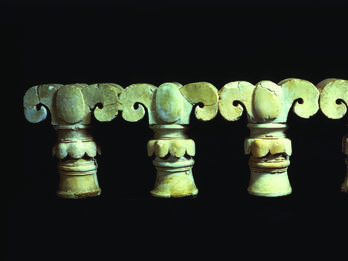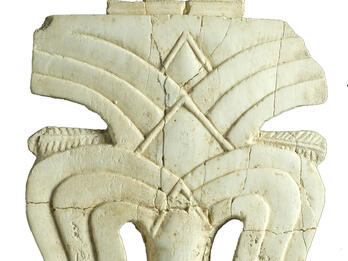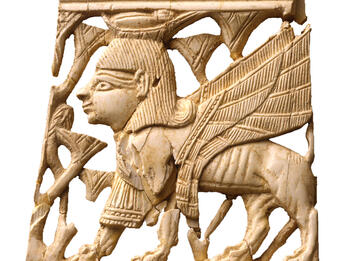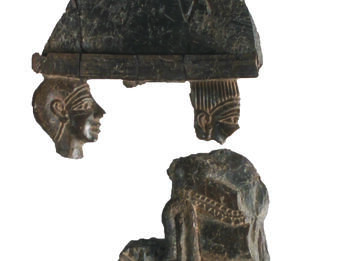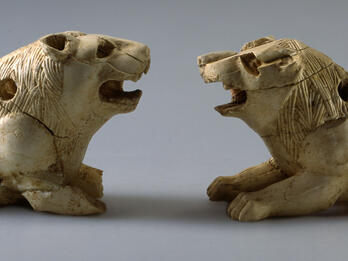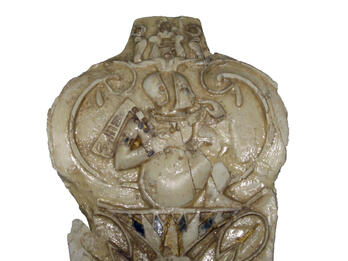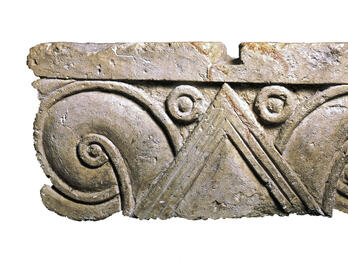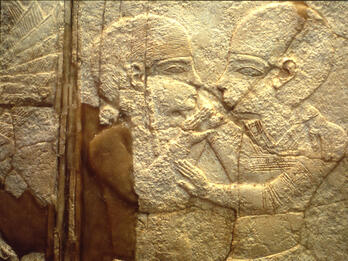Showing Results 1 - 9 of 9
Restricted
Image
Palm imagery is a common motif in decorative architectural elements like window balustrades. Each of the four columns in this partial restoration from the biblical period is six inches in diameter and…
Places:
Ramat Rahel, Land of Israel (Ramat Rahel, Israel)
Date:
Iron Age II, Late 8th–Early 7th Century BCE
Subjects:
Categories:
Restricted
Image
This and the next several ivories come from the approximately twelve thousand ivory pieces and fragments that were found in the royal compound in the city of Samaria, capital of the Northern Kingdom…
Places:
Samaria, Land of Israel (Samaria, Israel)
Date:
Iron Age IIA–IIB, 9th–8th Century BCE
Subjects:
Categories:
Restricted
Image
Sphinxes are among the most ubiquitous images on Iron Age Levantine ivories. The sphinx combines the features of several animals; it has the head of a human, the wings of an eagle, and the body of a…
Places:
Samaria, Land of Israel (Samaria, Israel)
Date:
Iron Age IIA–IIB, 9th–8th Century BCE
Subjects:
Categories:
Restricted
Image
Engraved tridacna (clam) shells like this one from Arad seem to have been used as cosmetic containers in the Near East and Mediterranean worlds in the late seventh and early sixth centuries BCE. This…
Places:
Arad, Land of Israel (Tel ‘Arad, Israel)
Date:
Iron Age IIC, Second Half of 7th–Early 6th Century BCE
Subjects:
Categories:
Restricted
Image
This ivory openwork inlay from Samaria depicts a figure enthroned on a cushioned chair, perhaps at a banquet, with an attendant standing behind. Royal banquet scenes, common in ancient Near Eastern…
Places:
Samaria, Land of Israel (Samaria, Israel)
Date:
Iron Age IIA–IIB, 9th–8th Century BCE
Subjects:
Categories:
Restricted
Image
In the ancient Near East, images of paired lions served as guardians at building entrances and on furniture, where these two figurines from Samaria were presumably placed. According to 1 Kings 10:19…
Places:
Samaria, Land of Israel (Samaria, Israel)
Date:
Iron Age IIA–IIB, 9th–8th Century BCE
Subjects:
Categories:
Restricted
Image
This leaf-shaped ivory relief from Samaria depicts Horus as a child sitting on a lotus flower. The lotus was a symbol of regeneration, and because, in Egyptian belief, each pharaoh was considered an…
Places:
Samaria, Land of Israel (Samaria, Israel)
Date:
Iron Age IIA–IIB, 9th–8th Century BCE
Subjects:
Categories:
Restricted
Image
The palm and the palmette are common iconographic elements in ancient Near Eastern art, appearing, for example, in ivory decoration (see Ivory and Bone Carvings and Engraved Seashells) and in Assyrian…
Places:
Ramat Rahel, Land of Israel (Ramat Rahel, Israel)
Date:
Iron Age II, Late 8th–Early 7th Century BCE
Subjects:
Categories:
Public Access
Image
Embracing couple in ivory inlay, Ugarit, 14th century BCE. This ivory inlay decorated the royal bed from the court of the kings of Ugarit (Syria). The woman has her left arm around the man and with…
Places:
Ugarit, Ugarit (Latakia, Syria)
Date:
14th Century BCE


